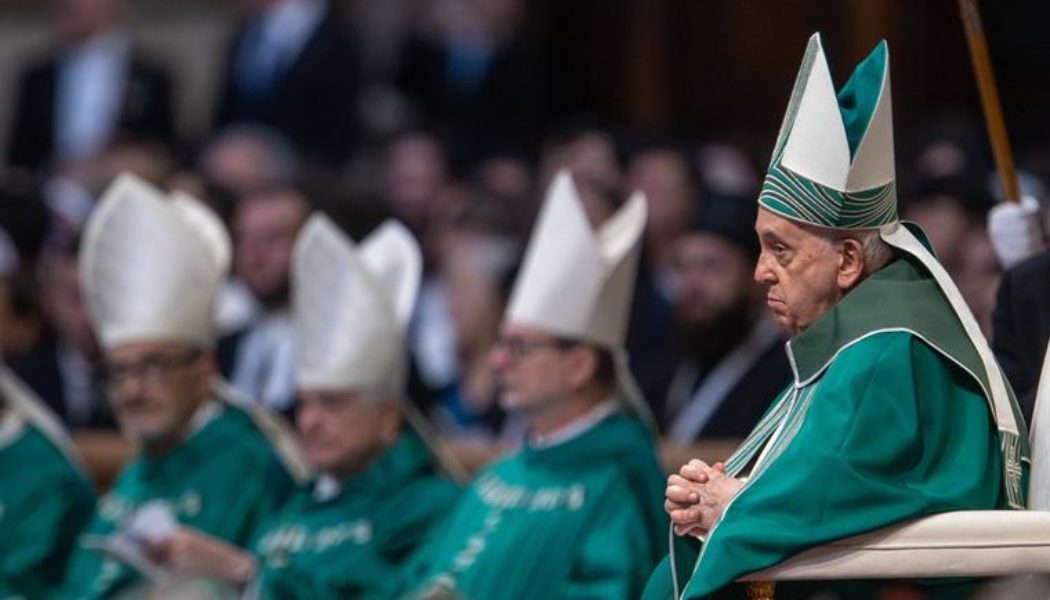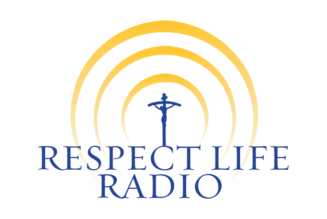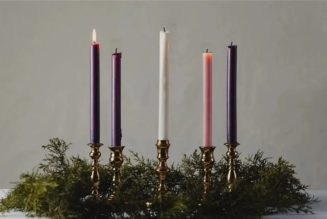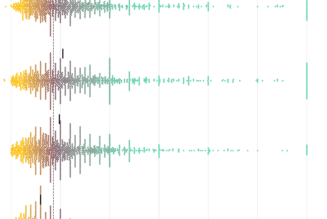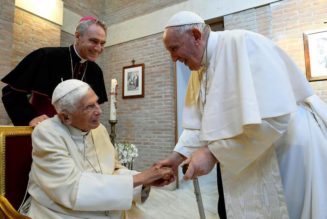
Editor’s Note: This story has been updated.
The Synod on Synodality assembly approved a 42-page summary report on Saturday night — but only after some significant changes were made to an initial draft.
The final summary report did not include the term “LGBTQ+”, which was present in the draft document that was first given to synod members on Wednesday, Oct. 25 and obtained by the Register at that time. Likewise, a proposal appearing to call for a permanently in-session synod providing consultation to the Pope did not make it into the final summary report, which will serve as the basis for the synod’s October 2024 session.
Language suggesting the need to reconsider the extent to which “sexual difference should shape ecclesiology and approaches to ministry” — an apparent reference to the Church’s understanding that only men are eligible to be ordained to holy orders, and therefore exercise certain ministries of teaching, governance, and sanctification — was also removed.
1,251 amendments to the draft text were submitted by synod delegates, and a writing team worked to incorporate them into the final version before it was given to members on Saturday and voted on later that night. Every paragraph in the final summary report was accepted by the assembly with the required two-thirds support.
While some items were removed from the final text, other elements completely absent from the draft appeared to be added. One particularly notable instance of this was the addition of a proposal to place men who have left the priesthood into “a pastoral service that enhances their training and experience,” on a case-by-case basis.
In several cases, references underscoring the importance of Church teaching were added. For instance, the word “magisterium,” which refers to the authoritative teaching of the Catholic Church, appears 10 times in the final version, while only four references were made in the original draft.
In a specific case, a proposal for a group of experts to engage in “shared discernment” on controversial “doctrinal, pastoral and ethical issues,” including issues related to gender, sexuality, and the end of life, was tweaked to underscore that this discernment should be conducted “in light of the Word of God, Church teaching, theological reflections, and, valuing the synod experience.”
“LGBTQ+” Terminology Rejected
The acronym “LGBTQ+” did not appear in the final report, despite being in both the synod’s instrumentum laboris and, in a different form, in the initial draft.
In the instrumentum laboris, the working document that guided the Synod on Synodality assembly discussions, phrases like “LGBTQ+ Catholics” and “LGBTQ+ persons” were included.
The use of “LGBTQ+” in this way is contested by many bishops and theologians, who argue that it unhelpfully frames an individual’s sexual attractions and/or sense of gender as a foundational part of his or her identity. Others, however, have pushed for Church documents to include this terminology, which is popular in secular Western societies but faces strong resistance in places like Africa and Eastern Europe.
But following assembly discussions, the initial draft of the summary report instead mentioned that the assembly had spoken not of “LGBTQ+ people,” but “people who identity as LGBTQ+.” Some Catholics consider that phrasing to be less problematic, because it uses “LGBTQ+” as a subjective identification, not a state of being.
However, by the time the final summary report was released, any mention of “LGBTQ+” was removed altogether. Instead, in the place where the draft had spoken of “people who identify as LGBTQ+,” the document spoke of “people who feel marginalized or excluded from the Church because of their marriage situation, identity, and sexuality.”
The summary report did, however, use the terms “sexual orientation” and “gender identity” at one point.
One possible explanation for this shift in terminology between the three documents is that, in the face of concerns from the assembly about the use of terms like “LGBTQ+ people,” drafters shifted to “people who identify as LGBTQ+” as an attempt to address concerns while also keeping the acronym in the document. It’s absence from the final summary, then, would be explained by significant push back via the form of amendments.
The absence of “LGBTQ” terminology was perceived as a major blow by some activists and media figures, with some news entities framing their entire coverage of the synod report accordingly. Synod member Jesuit Father James Martin, an American priest who regularly uses the “LGBTQ+” paradigm in his activism and ministry, also expressed his disappointment, suggesting that the document’s failure to describe Catholics who experience same-sex attraction or gender dysphoria as “LGBTQ” as akin to not mentioning them.
These responses did not acknowledge that the synodal assembly expressed “a deep sense of love, mercy and compassion” for “people who are hurt or neglected by the Church, who desire a place to come ‘home’ where they can feel safe, be heard and respected, without fear of feeling judged.” The report also said “the assembly reaffirms that Christians cannot disrespect the dignity of any person.”
The push to include “LGBTQ+” was just the latest in a longstanding effort to get terminology about sexuality and identity derived from a decidedly post-Christian Western paradigm incorporated into universal Church documents. Given the fact that synod reports can be said to speak for a large and geographical representative assembly, they are frequently targeted.
A similar scenario, for instance, played out at the last ordinary assembly of the synod.
At that assembly, the 2018 Synod on Young People, the term “LGBTQ” appeared in the instrumentum laboris, or working document, even though it hadn’t been mentioned in the report presented by young people who had attended the pre-synod meeting.
The term’s insertion, which was apparently made by synod organizers, was hailed as a watershed moment by the media and activists, but it was with something bigger in mind: “LGBTQ” making it into the synod assembly’s final report, thereby giving the impression that use of the term had received universal approval, entrenching it more firmly in the Church’s vocabulary.
But the Synod on Young People’s final document included no mention of the term.
Activists thought that this year’s Synod on Synodality synod would be different, their optimism likely bolstered by the full participation of non-bishop voting members who use LGBTQ terminology, like Father Martin.
No ‘Super Synod’
The Synod on Synodality’s summary report underscored that participants experienced “evangelical joy” by taking part in the assembly — but perhaps not enough to make it a perpetual feature in the Church.
Absent from the final text was a proposal in the draft “to establish a permanent synod of Bishops elected by Episcopal Conferences to support the Petrine ministry.”
The Synod of Bishops, instituted by Pope St. Paul VI in 1965, already is a permanent, canonically recognized organ of the Church. It holds ordinary assemblies, typically every three years, and most of the members who participate in those assemblies are elected by their respective bishops’ conference.
The draft proposal, then, likely referred to something even more substantial and regular, such as a synodal body that is permanently “in session,” with times when members are gathered together to engage in discussion and voting, and intervals when they are back in their respective dioceses.
But the proposal to establish a permanently-in-session Synod of Bishops to advise the Pope was made in the backdrop of big changes to the synod’s composition at this October’s assembly — most notably the inclusion of significant numbers of non-bishop voters. And, in fact, the summary report presented this dynamic mostly as a positive, seemingly laying the groundwork for it to become a regular feature of what had been known as the Synod of Bishops going forward.
With that in mind, the proposal to “establish a permanent synod of Bishops” very well could be read as a gateway to creating a sort of “super synod” — a body of bishops, priests, religious, and laymen and women providing ongoing consultation to the Pope.
That proposal did not make it into the final version. Instead, in its place was language that had not been in the draft version about making the Council of Cardinals, a group of 9 senior prelates who advise Pope Francis, a “synodal council.” The phrase is ambiguous, but given the association between synodality and greater involvement of non-bishops, it’s not unreasonable to think it’s pointing to the participation of non-cardinals in the “Pope’s cabinet” in some way — perhaps even religious sisters and laywomen.
Relatedly, the same section of the summary report also included a proposal found nowhere in the draft to carefully examine “whether it is appropriate to ordain prelates of the Roman Curia as bishops” — possibly the latest instance of decoupling episcopal ordination from Church governance, a priority during the Francis pontificate.
Finding Consensus
According to synod organizers, 1,251 amendments to the draft text were proposed by the assembly’s 364 voting delegates — 1,125 from the small groups, and an additional 126 from individuals. The amendment requests applied to individual paragraphs, and could call for alterations, additions, or deletions.
Like most of the proceedings at the Synod on Synodality, information about the amendment process, such as how many amendments were submitted on each paragraph and what they requested, was kept confidential.
The synod writing team received those amendments on Thursday, and the group had just over 24 hours to synthesize all the requests for changes into a version that members received on Saturday, hours before the final vote.
Given the quantity of amendments and the lack of time to incorporate them, many doubted that the writers could tweak the text enough to satisfy the assembly. As a result, there were concerns that several paragraphs would not receive the two-thirds majority necessary for inclusion into the document, or that voting itself would be significantly delayed.
The vote was later than expected, but the wait was likely worth it for organizers, as each of the reports’ paragraphs received the requisite level of support, and the assembly ended their nearly four weeks of deliberation on a note of unity.
